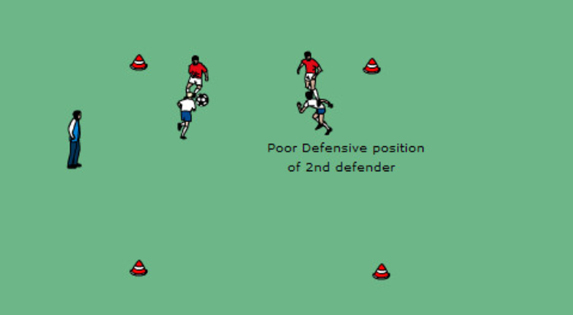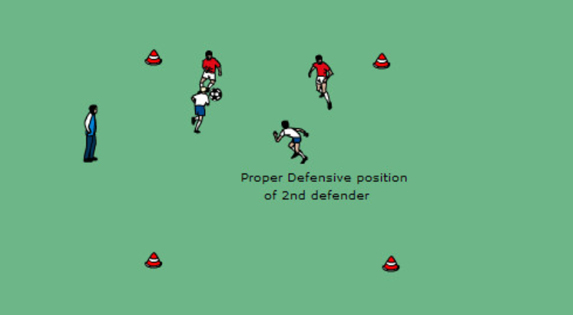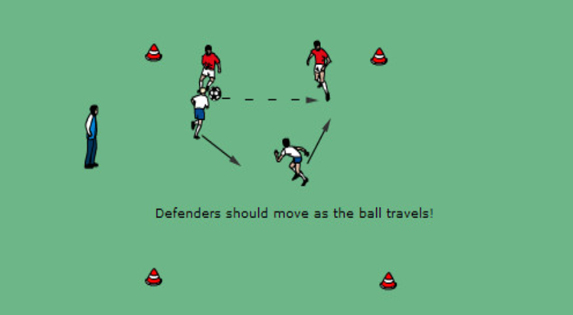Before deciding on “What system to play” or focusing on your team defending you must recognize that defensive success is first and foremost based on quality 1 vs. 1 defending. Getting pressure on the player with the ball is vital if the rest of the team is to carry out their defensive responsibilities. Only when this pressure takes place can the remainder of the players get “compact” and take away space from the attacking team. There are three key principles to successful 1 vs. 1 defending:
- Quick Pressure- The player nearest the ball must “close the space” as quickly as possible as soon as the ball is played to his opponent. You should close ground on your opponent as the ball is traveling to the attacker, do not wait until he/she has received the ball. Defender has three priorities:
- Intercept the Pass- if you can anticipate the attackers’ actions, but never commit to this unless you are sure you can get there.
- Challenge the First touch- Be in a position that you can “steal” the ball off of a poor first touch.
- Contain the attacker- Deny space to turn or pass in a penetrating manner.
- Touch Tight Pressure- When closing down space, it is important that you don’t overrun the play. As a rule you should slow down about 5 yards from the attacker and gradually take away the remaining space in a controlled defensive position.
- You want to be in a position that the attacker feels uncomfortable, and if he makes a mistake you can win the ball.
- You are close enough that you limit the attackers’ vision of the field.
- You cut off forward passing lanes, making play more predictable for your supporting defenders.
- Patient Pressure- Good defenders will recognize that they do not need to win the ball immediately. If you approach the attacker quickly and under control, taking away his space, you will shift the initiative to the attacker. Most attacking chances are created through poor and impatient defending. General rules for “Patient pressure” are:
- Don’t Dive In
- Be Cool and Alert- Ready to take the ball when it’s exposed
- Tackle with Confidence- Be quick enough to poke the ball away or hard enough to send the ball forward through the attacker.
Something to consider- One of the best times to win the ball back is in the moments after you’ve given away possession. If you can get immediate pressure on the ball from the defensive player closest to the ball, often the player who just lost it, the attacking team won’t be as organized and will likely turn the ball over. In a worst case scenario you can eliminate their ability to play forward.
Common Mistakes in Young Defenders
- Failure to get touch tight. Concede too many options to the attacker (shots, penetrating passes, etc.)
- Failure to show patience. Try to win the ball too often and too early. Defenders need to learn to control their momentum. Let the attacker make a mistake and then pounce.
- Poor Transition. Young players drop their heads on loss of possession and leave their teammates prone to the counter-attack.
Summary: As you can see the role of the first defender is vital to the success of team defending. If we do a poor job in applying pressure to the ball and taking away the attackers options the whole defensive system will suffer. It is very important that we spend time teaching each player the principles of individual defending. The 1 vs. 1 is the foundation of the game. This doesn’t just apply to the attacking principle, but defensive as well.
2v2 Defending: Pressure and Cover
The 2v2 situation is the smallest form of teamwork in the game of soccer, but remains one of the most important situations for a player to master no matter what their level of play. A coach must recognize that defensive success is first and foremost based on quality 1 vs. 1 defending. Getting pressure on the player with the ball is vital if the rest of the team is to carry out their defensive responsibilities. Only when this pressure takes place can the remainder of the players get “compact” and take away space from the attacking team. Assuming that proper pressure to the ball is exhibited, now the role, responsibilities and positioning of the 2nd defender becomes important.
Considerations for the 2nd defender:
- The 2nd defender or “covering defender” should position himself in a way that he can pressure the ball if the 1st defender is beaten on the dribble, but remain in a position that he can “close the space” on the 2nd attacker if the player on the ball chooses to pass.
- The 2nd defender must communicate with the player pressuring the ball (the 1st defender). Simple and concise instruction is vital! Force right, Force left, Contain are all good examples of communication from the 2nd defender.
- The distance between the 1st and 2nd defender is of the utmost importance. The 2nd defender mustn’t get too close to the 1st defender. He should never position himself in a way that the 1st attacker can beat both the 1st and 2nd defender in the same movement. However the 2nd defender must not be too far away from the 1st defender. This will leave the 1st defender isolated and actually create a 1v1 situation.
- The 1st and 2nd defenders must be prepared to reverse roles regularly when the ball is passed. It is important that both players are on the same page of when to reverse roles and don’t get caught chasing the ball.
The roles and understanding of the 1st and 2nd defenders responsibilities can only become cohesive through repetition. The best way to provide these opportunities is through small sided games where players are constantly confronted with opportunities to be the 1st defender (pressuring) and 2nd defender (covering). Below we’ll look at a few visuals of incorrect and correct positioning between the 1st and 2nd attacker. I have chosen to keep the visuals in a 2v2 setting to simplify the concepts, but the same principles apply all the way up to the 11 v11 game.
Incorrect positioning of the 2nd defender:
In the picture (right) you see a common mistake made by the 2nd defender. When the 2nd defender gets too tight to the 2nd attacker (supporting the 1st attacker) he provides no cover to the 1st defender. This creates a 1v1 situation which is a favorable situation for the attacking team.
Proper positioning of the 2nd defender:
In the picture (right) you see a much better positioning of the 2nd defender. By being “pinched in” and slightly deeper than the 1st defender the 2nd defender protects the 1st defender if he is beaten in the 1v1 challenge, can communicate with the 1st defender, and remains in a position that he can pressure the 2nd attacker if he is to receive a pass.
Changing of defensive roles:
As stated previously, the 1st and 2nd defenders must be prepared to reverse roles when the ball is passed. It is important that both players are on the same page of when to reverse roles and don’t get caught chasing the ball. The key to this situation is that the defenders change roles as the ball is traveling. As the 1st attacker passes the ball to the 2nd attacker, the 2nd defender must quickly close the space on the player receiving the ball eliminating the option to penetrate. The original 1st defender must now “pinch in” and “drop off” into a covering position and fulfill the role of the 2nd defender. New proper defensive positions pictured below.

Summary: As you can see the cooperation between the 1st defender and 2nd defender is vital to the success of team defending. If we do a poor job of applying pressure to the ball and “cover” for the player doing so, the whole defensive system will suffer. It is very important that we spend time teaching each player the principles of both individual defending and small group defending. The 2v2 confrontation offers players to learn the most basic concepts of teamwork with continuous opportunities to experience the roles of both the 1st and 2nd defender. Once players are comfortable recognizing proper positioning in this format a coach should progress to 3v3 or 4v4 games where the same principles apply, but may be more difficult for the players to recognize. Note: It can be helpful to apply the offside rule when teaching defensive concepts. This will prevent the defender from unnecessarily chasing an attacker when he runs into a deep offside position. However the concepts of pressure and cover should remain the top priority, it shouldn’t be a time to teach an offside trap.


